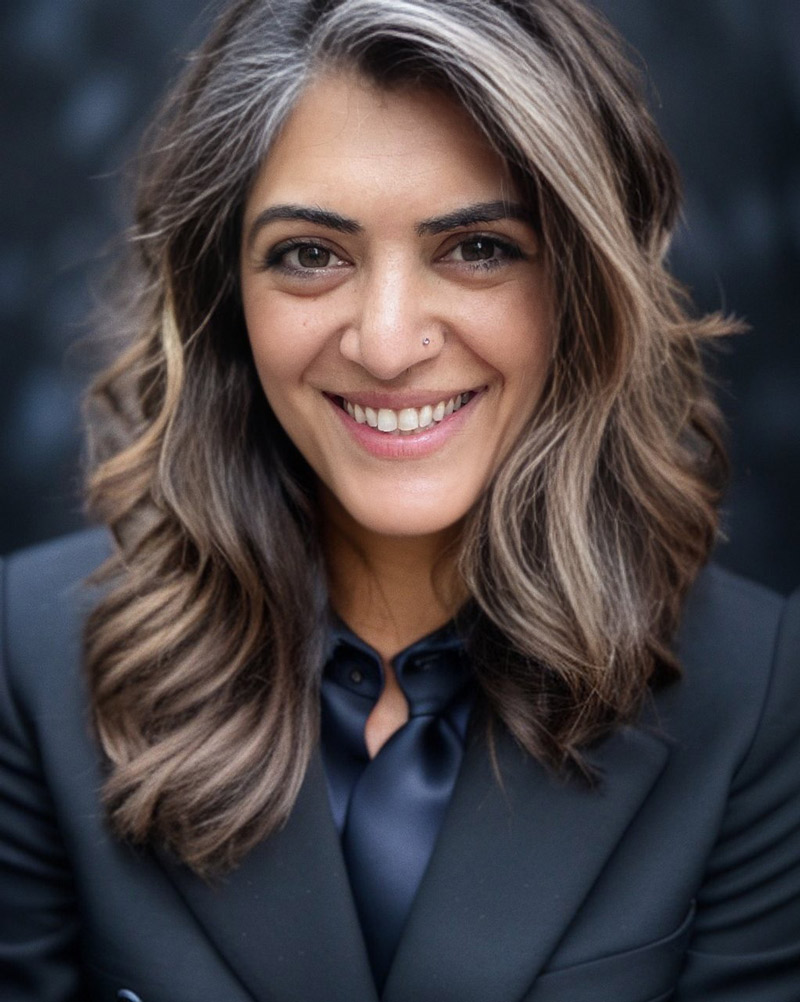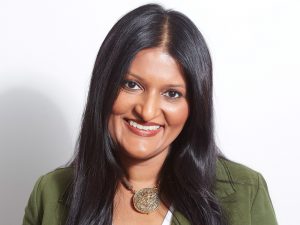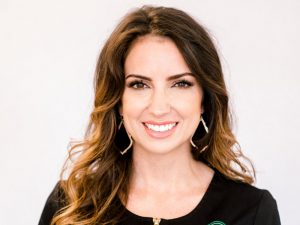Today’s global landscape is fraught with challenges that demand innovative solutions, and Somia Sadiq stands out as a beacon of dedication and creativity in our current environment. Born of the historic lands of post-colonial Punjab and Kashmir, she brings immense cultural insight into her extensive work spanning environmental sciences, natural resources management, and more.
However, Somia’s expertise doesn’t stop there; it extends into critical realms such as negotiations, counterterrorism, and the prevention of violent extremism. Somia’s unique combination of deep-rooted knowledge and cultural heritage equips her with a uniquely informed and compassionate approach to addressing multicultural complexities and global crises.
Through her innovative work, she seeks to empower communities and practitioners alike, utilizing a trauma-informed approach that acknowledges and addresses the undercurrents of conflict and distress affecting societies across the globe. Her ground-breaking contributions include the development of an all-encompassing impact assessment model, which synergizes multiple knowledge systems to effectively address complex environmental and societal challenges. Furthermore, her pioneering Identity-based conflict transformation model has made significant strides in supporting peacebuilding, healing, and transformation efforts among conflicting groups.
Somia’s work not only bridges gaps between disparate communities, but it also paves the way for a future where collective well-being and sustainable peace are within reach. Check out our full interview with her below.
Can you describe what first drew you to work in peacebuilding and environmental planning?
Somia Sadiq: My great-grandfather, grandfather, and then my father were often invited to help settle conflicts. They did so by balancing the need to come to an agreement while honoring social cohesion, rituals, and customs. Often, conversations would take days, entailing a lot of visiting, food, and laughter. Space was created and held for stories, for sharing, and for expression.
Carrying those memories in my being, I have been drawn to finding ways to honor ancestral approaches to transformation. And, I see immense value in adopting these approaches in navigating environmental challenges, environmental conflicts, and environmental opportunities in our world today.
How does your work at Narratives integrate trauma-informed practices with environmental planning for Indigenous communities?
Somia Sadiq: Adopting a trauma-informed approach means ensuring care for ourselves as well as those we work for and with. It also means we don’t have a perfect blueprint, but we must take the time to understand the needs of our teams working on initiatives as well as each community’s own resources and needs.
We build a trauma management plan for every project we work on, which speaks to specific ways that we’ll approach understanding and managing trauma for ourselves and others. We also incorporate various exchanges, knowledge jams, training, and development on trauma-related topics in our everyday operations. Our team has access to a clinical psychologist who conducts team coaching sessions every 6 weeks so we can continue to learn and grow together.
Can you share a specific story where you helped amplify voices that traditionally go unheard?
Somia Sadiq: Amplifying voices is an everyday occurrence. It is important for us to not become the voice but stay in the background and showcase our clients.
Recently, we had the incredible opportunity to share the international stage with one of our Indigenous clients who received an Excellence award for an innovative model for bringing together two knowledge systems. It was incredible seeing them being recognized by thousands of impact assessment practitioners representing over 90 countries.
How does the United Nations Declaration on the Rights of Indigenous Peoples inform your work and approach to Narratives?
Somia Sadiq: For us, UNDRIP is an enabling mechanism that creates the perfect push to honor Indigenous laws, customs, rituals, and culture so Indigenous communities can push for agreements, assessments, policies, and law-making to be rooted in their ways of being. By encouraging the application of UNDRIP, we are able to push for Indigenous-led management to be front and center as we navigate global crises such as climate change.
What challenges have you faced in integrating multiple knowledge systems into your environmental planning and peacebuilding efforts?
Somia Sadiq: A key challenge is the assumption that western / euro-centric approaches are superior. So, we must continue to demonstrate otherwise. This mindset sadly also trickles into how people educated in different ways and educated in different knowledge systems relate to each other on a personal level.
A holistic approach to environmental planning and peacebuilding requires us to step outside that bias, and take the time to listen, understand, and really give space, hold space for ancestral knowledge and other ways of being, to flourish.
As the CEO of Narratives, what does a typical day look like for you?
Somia Sadiq: It varies by the minute! Sometimes visiting clients in communities, coaching team members, checking in with the crew on project strategies, soliciting feedback on ideas, testing new ideas, rallying up the troops to geek out on a topic, brainstorming how to push boundaries on the next project, and sometimes when the weather is nice, joining people on walks, coffee runs, or ice cream runs.
Once in a while I get to review resumes for new dogs looking to join our canine and wellness unit – definitely a highlight!

How do your ancestral roots in Punjab and Kashmir influence your perspective and approach in your work?
Somia Sadiq: I come from a very strong story-based, narrative-based culture where knowledge is shared, transferred, and promoted through oral history, customs, rituals, and coming together to eat, feast, sing, and dance. This identity allows me to listen and be and learn from all I work with, just as I’ve learned from my ancestors.
I am also an intergenerational survivor of the Partition and carry in my blood memory and through many traumatic stories from our shared history the impacts of conflict – this helps me approach my work with care, curiosity, and humility. And lastly, I come from a strong line of kickass matriarchs whose energy and tenacity allows me to push for change that is inclusive, anti-racist, anti-oppressive, and rich in resilience and collective action.
What are some misconceptions people might have about trauma-informed business practices?
Somia Sadiq: When people hear trauma-informed, they think we’re talking about yoga and meditation, and that is where their thinking ends. It’s too fluffy, too soft, and hence uncomfortable. My job is to help people recognize the science, neurobiology, psychological, and sociological impact and opportunities associated with understanding trauma so we can all ensure our work is doing no harm – both to ourselves and to others.
Can you share an instance where your intervention led to a breakthrough in negotiations or mediations?
Somia Sadiq: A few strategies can be handy. I’ll share a couple.
I often find that the temperature in the room always changes when we acknowledge how challenging it might be for the other side to push the status quo to make something creative happen.
Another one is it is important for people to be a part of creating the solutions themselves as opposed to relying on negotiators to come up with solutions. To foster this, one principle of negotiations I take on is that I insist on bringing lawyers into the room only after communities/participants have themselves agreed on what seems fair. This helps people maintain ownership of the process, build accountability, and reclaim their agency, which may have been eroded as a result of the conflict.
Thirdly, remember to be human. Remember to laugh together, remember to eat together, bring in ways to enjoy music together, remember to leverage things that transect boundaries.
What advice would you give to young professionals who want to work in the fields of peacebuilding and environmental planning?
Somia Sadiq: Connect with peacebuilders! Let’s talk! There are a lot of organizations around the world doing incredible work in this space – such as Mediators Beyond Borders International, such as Kahanee. Find your people. We need you!
How do you balance the technical aspects of natural resource management with the emotional and cultural dimensions in your projects?
Somia Sadiq: Accepting that those two things are interconnected and interwoven, and it is, in fact, artificial to try and separate them. So we might as well accept that and stop trying to keep culture and emotion out of technical aspects. Expanding our awareness to other ways of being, approaching our technical work with deep curiosity, and a desire to change can go a long way in bridging the gap.
How do you think the field of environmental planning and peacebuilding will change in the context of climate change and global political shifts?
Somia Sadiq: As conflicts escalate, we see increasing polarization in our societies, increasing othering, increasing hate, increasing this or that, with nothing in between. We see this because everyone is scared, and doesn’t know how to have a difficult conversation without losing control.
We need to create spaces for people to come together and acknowledge the fears, acknowledge the impacts, and find ways to grow together, to build resilience and understanding, and skills together. We need dialogue. We need to talk. We need to stop avoiding conversations on difficult topics. We need more peacebuilders!
Lastly, is there a specific mantra, quote, or affirmation that you hold close to your heart (This will be for a graphic we use on social with your photo).
Somia Sadiq: Beyond the land of wrongdoing and rightdoing is a field. I will meet you there – Rumi.
Additional Links:
- Narratives: https://narrativesinc.com/
- LinkedIn: https://www.linkedin.com/in/somia-sadiq-0b21596a
Emily Sprinkle, also known as Emma Loggins, is a designer, marketer, blogger, and speaker. She is the Editor-In-Chief for Women's Business Daily where she pulls from her experience as the CEO and Director of Strategy for Excite Creative Studios, where she specializes in web development, UI/UX design, social media marketing, and overall strategy for her clients.
Emily has also written for CNN, Autotrader, The Guardian, and is also the Editor-In-Chief for the geek lifestyle site FanBolt.com






